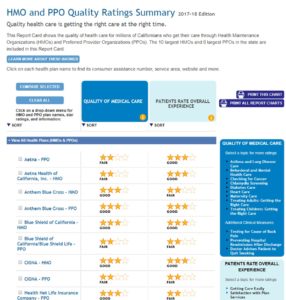 The California Office of the Patient Advocate (OPA) has released its 2017-18 Health Care Quality Report Card, a tool that helps consumers compare the quality of health plans and find information to help them get the care they need. With California’s Open Enrollment starting November 1st and continuing until January 31, 2018, consumers can evaluate the health plan and medical group options in their county and see how they fare on a variety of quality measures. The tool helps consumers shopping for coverage through Covered California or with employer-based coverage make decisions not just based on how much the health plan costs, but also whether they provide the best care based on your medical needs.
The California Office of the Patient Advocate (OPA) has released its 2017-18 Health Care Quality Report Card, a tool that helps consumers compare the quality of health plans and find information to help them get the care they need. With California’s Open Enrollment starting November 1st and continuing until January 31, 2018, consumers can evaluate the health plan and medical group options in their county and see how they fare on a variety of quality measures. The tool helps consumers shopping for coverage through Covered California or with employer-based coverage make decisions not just based on how much the health plan costs, but also whether they provide the best care based on your medical needs.
With this report card consumers can compare health plan quality as open enrollment begins this week.
Consumers can use the Report Card tools to filter health plan comparisons by health topics like, “Cancer Care,” or “Diabetes Care,” and see the plan’s rating, ranging from Excellent to Poor. The report card rates health plans on both the quality of medical care a patient receives as well as consumers’ rating of their overall experience with their plan. To measure the quality of medical care a patient receives, plans are rated on how successful each is at helping patients get the care they needed using specific quality markers. For example, when measuring quality of care on an issue like diabetes care, the report card measures how well a provider controls blood sugar and blood pressure for diabetes patients, among other care markers. The report card also provides a rating on patients overall experience with the plan, by rating how easily a consumer can access care, and rating satisfaction on plan features like customer service and how quickly health plans pay claims.
Updates to the 2017-18 California Health Care Quality Report Card include a HMO/PPO comparison tool, where you can filter HMO and PPO plans next to one another to make direct comparisons. The star rating methodology has been updated to remove obsolete quality measures, better aligning it with data sets used by the National Committee for Quality Assurance to measure quality in the healthcare system. Information was collected from health plans and scored based on standards for quality of care set by the Healthcare Effectiveness Data and Information Set (HEDIS) performance measurement system to make sure that health plans offer quality care to their members. The HMO Report Card uses data from the CAHPS® (Consumer Assessment of Healthcare Providers and Systems) survey, which surveys a random sample of members from each HMO and PPO on their consumer experience.
Beth Abbott, Director of the Office of the Patient Advocate, says this tool is also beneficial for employers looking to select health plans for their employees. By 2018, the report card will also include information on the total cost of care, which is the average amount that health plans and patients of the medical group pay for all of the care provided for one year, for purchasers, helping businesses determine the best “bang for their buck” when purchasing coverage for employees.
The OPA also provides consumers with tips on how to compare health plans, questions to ask your doctor, and refers you to resources if you have a problem or complaint with your health plan. The OPA’s overall goal is to improve healthcare quality through publicly reporting data for consumers’ informed decision making.
The 2017 Health Care Quality Report Cards was published on October 31, 2017 and can be found here.